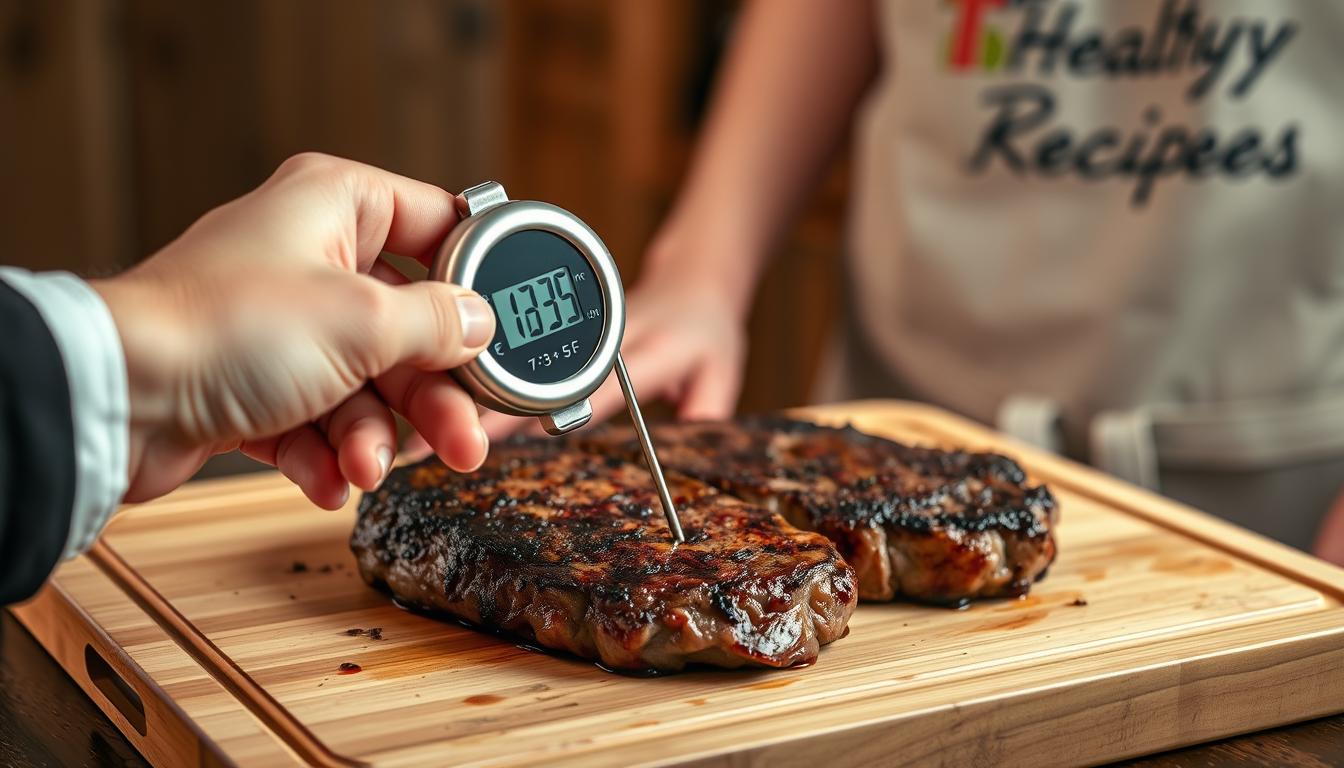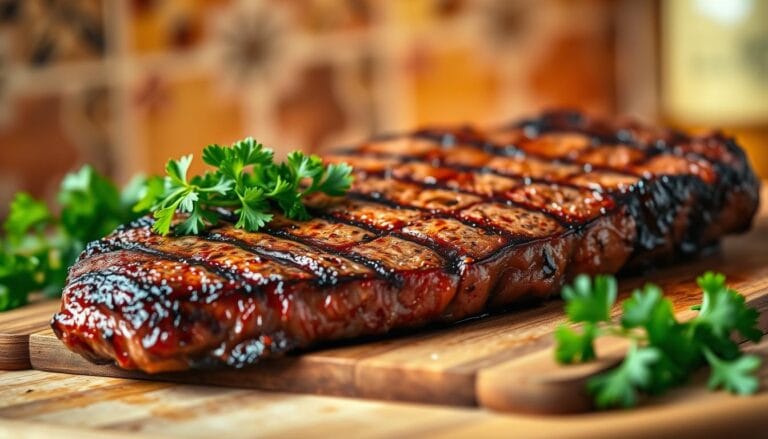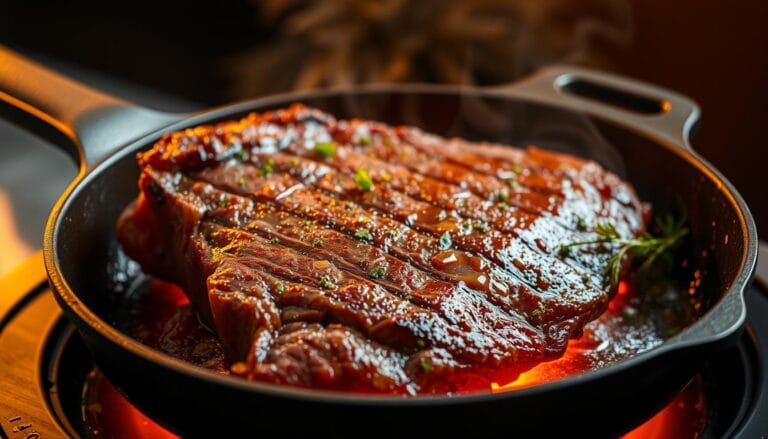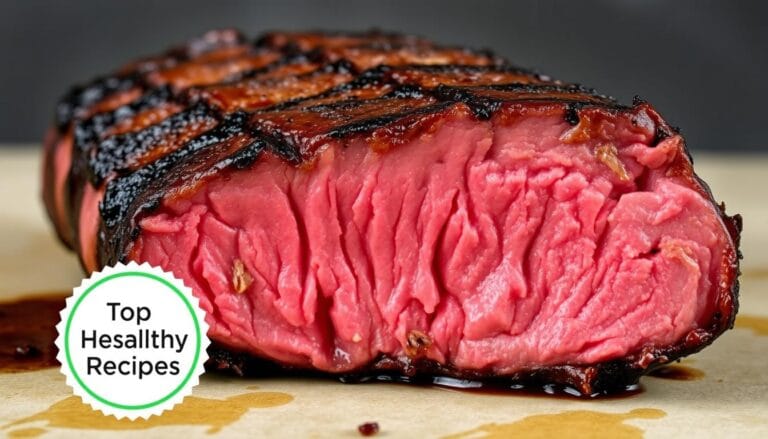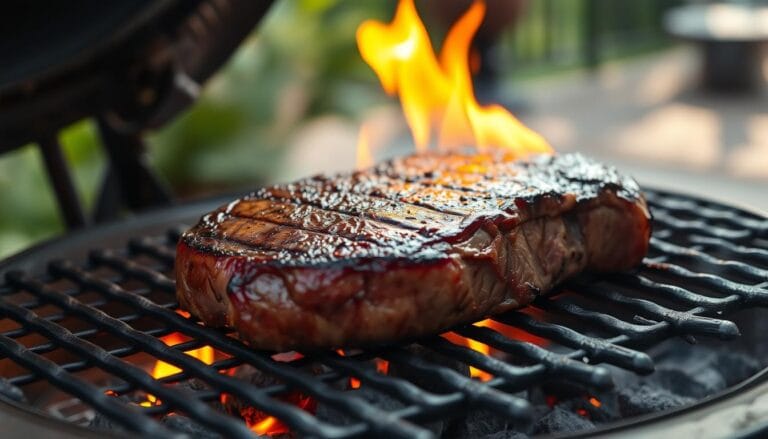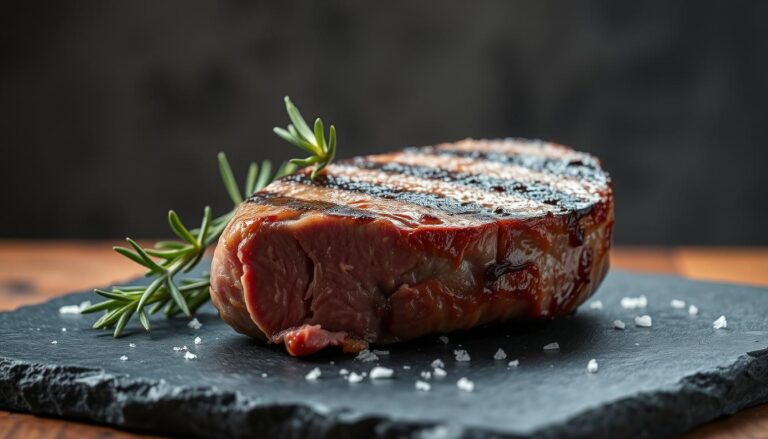Perfect Medium Steak Temperature : Juicy Every Time!
Table of Contents
Perfect Medium Steak Temperature : Juicy Every Time!
The temperature for a medium steak typically ranges from 135°F to 145°F. This level of doneness ensures a juicy and flavorful steak while maintaining a slight pink center. Achieving the perfect medium steak temperature is crucial for a consistently delicious dining experience. Remember to use a reliable meat thermometer to monitor the internal temperature accurately.
A perfectly cooked steak can make any meal special. Finding the right doneness is key, and many prefer medium. It’s about getting the medium steak temperature just right, keeping it juicy and flavorful.
Cooking a steak to the perfect medium steak temperature might seem hard. But with the right tips, it’s easy. Knowing the science behind doneness and the exact temperature targets is essential for delicious steaks.
Whether you’re new to cooking or a seasoned chef, learning to cook steaks just right is important. This guide will help you achieve perfect medium doneness every time.
Key Takeaways
- Understanding the science behind steak doneness.
- Precise temperature targets for achieving medium steak.
- Expert tips for cooking steaks to perfection.
- Common mistakes to avoid when cooking steaks.
- Techniques for ensuring consistent results.
Understanding Steak Doneness Levels
Achieving the perfect steak is all about knowing the different doneness levels. Steak doneness is how well a steak is cooked. It changes the steak’s texture, flavor, and overall taste.
What Do Doneness Levels Mean?
Doneness levels range from rare to well-done, with medium steak being a favorite. Each level has a specific internal temperature. For example, a medium steak is cooked to 140°F to 145°F (60°C to 63°C).
The internal temperature is key for the right texture and flavor. Using a meat thermometer is the best way to check doneness.
Visual Cues for Doneness
While a thermometer is best, you can also use visual cues. For a medium steak, look for:
- A firm texture, but soft to the touch
- A pink color, but not too red
- A bit of juiciness on the cut surface
Importance of Steak Thickness
The steak’s thickness affects cooking time and temperature. Thicker steaks need more time and careful temperature control. For example, a thicker steak might need lower heat to cook evenly.
Knowing about steak thickness helps you adjust your cooking. This ensures your steak is cooked just right, no matter its size.
The Perfect Medium Temperature
The ideal medium steak temperature is a sweet spot. It balances tenderness and flavor, making it a favorite among steak lovers. Cooking a steak to this temperature ensures it stays juicy and flavorful.
Target Temperature for Medium Steak
For a steak to be considered medium, it should be cooked to an internal temperature of 135-145°F (57-63°C). This range is key. It makes sure the steak is safe to eat and juicy.
Why Medium is a Popular Choice
Medium doneness is loved because it’s tender and juicy. It’s perfect for certain steak cuts with lots of fat. This fat makes the steak taste better and feel softer.
Flavor Profile of Medium Steak
A medium steak has a rich flavor. It has a caramelized crust and a juicy inside. This mix of textures and flavors is a treat. Serving it with dishes like shrimp on steak makes the meal even better.
| Doneness Level | Internal Temperature | Description |
|---|---|---|
| Rare | 120-130°F | Red and juicy, with a warm red center. |
| Medium Rare | 130-135°F | Pink throughout, with a hint of red in the center. |
| Medium | 135-145°F | Warm pink throughout, with a hint of firmness. |
| Medium Well | 145-155°F | Slightly firm, with a hint of pink in the center. |
| Well Done | 155°F+ | Fully cooked, with no pink color remaining. |
Equipment You’ll Need
To get the perfect medium steak, you need the right tools. Having the right equipment is key to cooking your steak just right.
Meat Thermometer Options
A meat thermometer is essential for a perfect medium steak. There are many types of thermometers, each with its own benefits.
- Instant-read digital thermometers give quick and accurate readings. They’re great for checking your steak’s internal temperature.
- Leave-in probe thermometers let you watch your steak’s temperature as it cooks. This ensures it stays at the right temperature.
- Wireless smart thermometers let you check your steak’s temperature from afar. They send alerts when it’s ready.
| Thermometer Type | Accuracy | Convenience |
|---|---|---|
| Instant-read digital | High | Quick readings |
| Leave-in probe | High | Continuous monitoring |
| Wireless smart | High | Remote monitoring |
Using an Instant-Read Thermometer
To use an instant-read thermometer, stick the probe into the thickest part of the steak. Make sure it’s not in fat or bone. Wait a bit until the temperature is steady, then read it.
For the best results, put the thermometer in the steak’s center. Avoid fat or bone.
Grill vs. Oven for Cooking
Both grilling and oven cooking can make a great medium steak. But they have different benefits.
Grilling adds a smoky taste and a nice crust. But, it can be hard to control the heat, mainly for thicker steaks.
Oven cooking gives even heat, making it easier to cook thicker steaks evenly. It’s a good choice for bigger steak cuts.
Preparing Your Steak
Before cooking, it’s key to prepare your steak right for a perfect medium temperature. You need to follow a few steps to ensure it cooks evenly and tastes great.
Choosing the Right Cut
The steak type you pick matters a lot. For a medium steak, go for ribeye, strip steak, or filet mignon. These cuts are juicy and full of flavor because of their fat and muscle.
| Steak Cut | Fat Content | Best For |
|---|---|---|
| Ribeye | High | Juicy and flavorful |
| Strip Steak | Medium | Balanced flavor and tenderness |
| Filet Mignon | Low | Tender and lean |
Seasoning Tips for Maximum Flavor
Seasoning boosts your steak’s natural taste. Salt and other seasonings should be applied just right. Too early, and it’s too salty. Too late, and flavors don’t get in deep.
Use spices like garlic, black pepper, and herbs like thyme or rosemary. They complement the beef’s taste.
Bringing Steak to Room Temperature
Letting your steak warm up to room temperature before cooking is smart. Leave it on the counter for 30-60 minutes. This makes it cook more evenly.
When it’s room temperature, heat gets in better. This helps you hit that perfect medium temp of 135-145°F.
By doing these prep steps, you’ll cook a medium steak that’s both tasty and tender.
Cooking Methods for Medium Steak
Whether you’re grilling, pan-searing, or oven cooking, hitting the ideal medium temp for steak is within reach. Different cooking methods offer unique advantages. Understanding these can help you achieve a perfectly cooked steak every time.
Grilling to Perfection
Grilling is a popular method for cooking steak. It adds a smoky flavor and a nice char on the outside. To grill a steak to medium doneness, preheat your grill to medium-high heat, around 400°F to 450°F (200°C to 230°C).
Use direct heat for searing, then move the steak to a cooler part of the grill to finish cooking it to the desired temperature. Here are some key grilling tips:
- Use a meat thermometer to check the internal temperature.
- For a 1-inch thick steak, grill for 4-5 minutes per side.
- Let the steak rest for a few minutes before serving.
Pan-Searing Techniques
Pan-searing is another excellent method for cooking steak. It offers a crispy crust on the outside and a juicy interior. To pan-sear a steak to medium, heat a skillet over high heat, add a small amount of oil, and sear the steak for 2-3 minutes on each side.
Then, reduce the heat to medium-low and continue cooking until the steak reaches your desired level of doneness. Some key pan-searing tips include:
- Choose a skillet that retains heat well, such as cast iron.
- Don’t overcrowd the pan; cook steaks one at a time if necessary.
- Use a thermometer to check the internal temperature.
Oven Cooking for Even Heating
Oven cooking provides a controlled environment for cooking steak. It ensures even heating. To cook a steak to medium in the oven, first sear it in a hot pan, then finish it in a preheated oven at 300°F (150°C) until it reaches the desired internal temperature. Here are some oven cooking tips:
- Use a wire rack on a baking sheet to promote air circulation.
- For a 1-inch thick steak, cook for 8-12 minutes in the oven.
- Let the steak rest before slicing and serving.
By mastering these cooking methods, you’ll be able to achieve a perfectly cooked medium steak, regardless of your preferred cooking technique. Remember, the key to a great steak is not just the cooking method, but also the quality of the steak and the attention to its temperature.
Monitoring Temperature
The secret to a perfectly cooked medium steak is knowing the right temperature. You need to make sure it hits the steak temp medium range of 135-145°F. This requires careful attention and the right techniques.
Using a Meat Thermometer Effectively
A meat thermometer is key for the perfect doneness. To use it right, put the thermometer into the thickest part of the steak. Make sure it’s not near any bone or fat. This is important for thicker steaks to get an accurate reading.
When you check the temperature, do it at the right time. For a medium steak, take it off the heat when it’s around 130-135°F. The temperature will go up a bit as it rests.
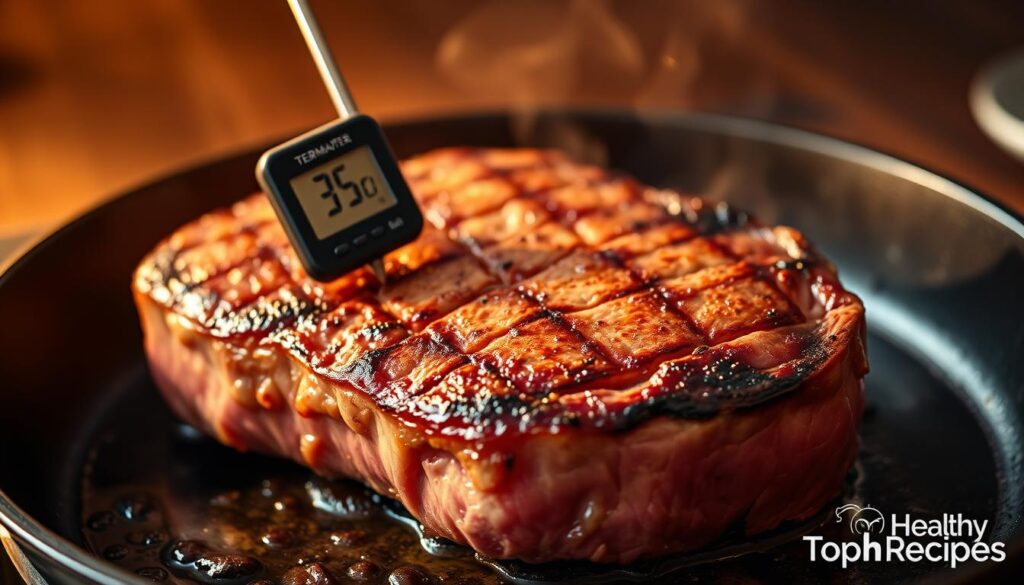
Understanding Carryover Cooking
Carryover cooking is important to know when cooking steak. It’s when the steak keeps cooking after it’s off the heat. The temperature can go up by 5-10°F. So, to get a perfect medium steak, take it off the heat a bit early.
Alternative Methods for Checking Doneness
Not everyone has a meat thermometer. But, there are other ways to check if your steak is done. The touch test is one. It compares the steak’s firmness to your hand. For medium, it should feel like the base of your thumb when relaxed.
Visual cues can also help. A medium steak will have a warm red center. While not as precise as a thermometer, these methods can guide you to a well-cooked steak.
Resting Your Steak
Cooking your steak to medium is just the start. The real magic happens when it rests. After cooking it to the perfect medium temperature, letting it rest is key for a juicy and flavorful steak.
The Importance of Resting
Resting your steak is more than a pause. It’s a critical step that lets the muscle fibers relax. When you cook a steak, the fibers contract, pushing juices to the surface. If you cut into it right away, these juices will spill out.
By letting it rest, the fibers relax and reabsorb these juices. This makes each bite as flavorful as possible.
Understanding temperature differences is helpful. For example, a medium rare steak is between 130-135°F. Resting is just as important for medium steaks, which are 140-145°F.
How Long to Let Your Steak Rest
The resting time depends on the steak’s thickness. Generally, let it rest for 5-10 minutes. Thicker steaks need longer, while thinner ones can be served sooner.
| Steak Thickness | Resting Time |
|---|---|
| Less than 1 inch | 5 minutes |
| 1-1.5 inches | 7-8 minutes |
| Over 1.5 inches | 10 minutes or more |
The Science Behind Resting
During resting, several changes happen in the steak. Carryover cooking is one, where the steak cooks a bit more after being removed from heat. This is because the inside is cooler than the outside. As it rests, the heat spreads out, making the temperature even.
“The resting period is when the steak’s internal temperature evens out, and the juices redistribute, making the steak more tender and flavorful.” – Expert Chef
Understanding and using the resting period right can improve your steak-cooking skills. It ensures your medium steak is not only cooked right but also juicy and full of flavor.
Serving Medium Steak
When your steak is cooked just right, it’s time to add the finishing touches. Serving a medium steak is more than just putting it on a plate. It’s about making sure every bite is perfect.
Ideal Sides for Medium Steak
Choosing the right sides can make your steak dinner even better. Roasted potatoes and creamed spinach are great choices. They match the medium steak temperature perfectly.
For something new, try grilled or sautéed veggies like asparagus or bell peppers. They add color and flavor to your meal.
Other tasty options include garlic mashed potatoes, roasted Brussels sprouts, or a fresh garden salad. The goal is to balance the steak’s richness with sides that offer different textures and tastes.
Pairing with Wine or Beer
The right drink can make your steak even better. For wine lovers, a medium-bodied red wine like Merlot or Syrah is perfect. These wines match the steak’s flavors without overpowering them.
If beer is your choice, a malty beer like an Amber Ale or Brown Porter works well. It adds to the steak’s richness, making for a great meal.
Presentation Techniques
How you present your steak matters a lot. Start by slicing your steak against the grain. This makes it tender and looks good too.
Adding a garnish like fresh herbs can brighten up your plate. Drizzling a sauce or jus over the steak can also boost its flavor and look. Taking care with your steak’s presentation makes it feel like a fancy restaurant meal.
Common Mistakes to Avoid
Getting a great medium steak is all about avoiding common mistakes. When cooking to a medium steak temp, several factors can affect the outcome. Knowing these pitfalls can help you get a better result.
Overcooking Your Steak
One big mistake is overcooking your steak. It’s easy to go from medium to medium-well or even well-done without a thermometer. To avoid this, use an instant-read thermometer to check the internal temperature often.
For a medium steak, the internal temperature should be between 130°F and 135°F (54°C to 57°C). If your steak is getting too hot, remove it from the heat and let it rest. This prevents it from cooking more.
| Doneness Level | Internal Temperature (°F) | Internal Temperature (°C) |
|---|---|---|
| Medium Rare | 120-125 | 49-52 |
| Medium | 130-135 | 54-57 |
| Medium Well | 140-145 | 60-63 |
Not Letting It Rest
Not letting your steak rest after cooking can make it less enjoyable. Without resting, the juices don’t redistribute, leading to a dry texture.
To fix this, let your steak rest for 5 to 10 minutes after cooking. This lets the juices spread out, making the steak more tender and flavorful.
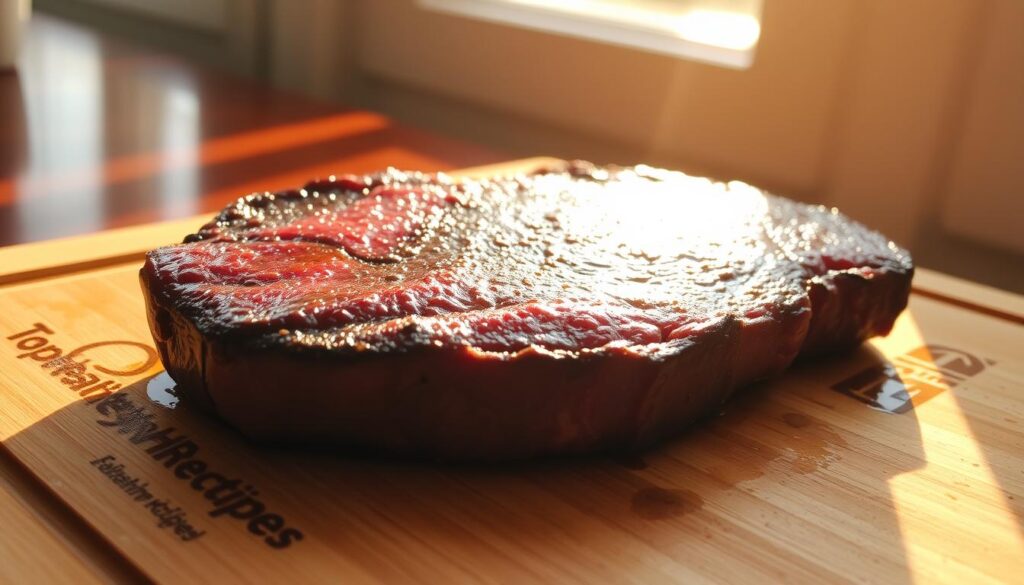
Choosing the Wrong Cut
Picking the right cut of steak is key for a great medium steak temp. Some cuts, like flank steak or brisket, are harder to cook to medium because of their thickness or connective tissue.
Go for cuts known to cook well at medium, like ribeye, strip loin, or filet mignon. These cuts have better marbling, which means more flavor and tenderness.
- Ribeye: Known for its rich flavor and tender texture.
- Strip Loin: Offers a balance of tenderness and flavor.
- Filet Mignon: Provides a tender and lean option.
Frequently Asked Questions
Whether you’re a seasoned grill master or a novice cook, knowing the answers to common questions about medium steak can elevate your cooking game. Achieving the perfect temp for medium steak is a nuanced process, and we’re here to guide you through some of the most frequently asked questions.
Adjusting Cooking Times
Cooking times can vary significantly based on several factors, including steak thickness, starting temperature, cooking method, and even altitude. For a medium steak, it’s important to adjust your cooking time. A general rule of thumb is to add 1-2 minutes per side for every additional 1/2 inch of thickness. For instance, a 1.5-inch thick steak will require more cooking time than a 1-inch thick steak.
To adjust cooking times effectively, consider the following factors:
- Steak thickness: Thicker steaks require longer cooking times.
- Starting temperature: Steaks at room temperature cook more evenly than cold steaks.
- Cooking method: Grilling cooks steaks faster than oven cooking.
- Altitude: Higher altitudes may require adjustments due to lower air pressure.
Reheating a Medium Steak
Reheating a medium steak without overcooking it can be a challenge. The key is to reheat it gently. Gentle oven warming is a recommended method, where you place the steak in a low-temperature oven (around 200°F) until it’s warmed through. Another effective method is sous vide reheating, which allows for precise temperature control.
As culinary expert,
“The secret to reheating steak is to do it slowly and gently, preserving the delicate balance of doneness you’ve achieved.”
By using these methods, you can enjoy your medium steak again without compromising its quality.
What If My Steak is Overcooked?
Overcooking can happen even to the best of us. If you find your steak overcooked, there are ways to salvage it. Slicing it thinly for sandwiches can make it more palatable, as can creating a flavorful sauce to add moisture and flavor. You can also repurpose the steak into other dishes like steak salads or steak tacos.
The key to dealing with overcooked steak is to be creative. As
“A good cook can turn even the most overcooked steak into a culinary masterpiece with a little creativity.”
Don’t be discouraged by overcooking; instead, see it as an opportunity to try something new.
Expert Tips for Steak Lovers
For those who crave a perfectly cooked medium steak, seasoned chefs have valuable tips. To achieve the ideal medium steak temperature, you need the right technique and understanding of flavor enhancement. We’ll explore expert advice on grilling, marinades, and different steak cuts to improve your cooking.
Insider Tips for Grill Mastery
Mastering the grill is key for a perfect medium steak. Creating temperature zones on your grill gives you more control. Adjust the burners on a gas grill or rearrange coals on a charcoal one. Wood chips can add a smoky flavor; soak them in water to prevent burning.
Some key grilling tips include:
- Preheating the grill to ensure a hot surface for searing
- Using an instant-read thermometer to check for the ideal internal temperature
- Minimizing lid opening to maintain consistent heat
Enhancing Flavor with Marinades
Marinades can greatly enhance your steak’s flavor without overpowering it. A good marinade balances acidic ingredients, oils, and spices. For a medium steak, avoid over-acidifying to prevent toughness. A simple marinade of olive oil, garlic, and herbs adds depth without overwhelming the steak’s natural taste.
Experimenting with Different Cuts
While ribeye and sirloin are favorites, other cuts like coulotte, tri-tip, or Denver steak offer unique flavors and textures. Experimenting with different cuts can help you find new favorites. Each cut may need slight cooking time and temperature adjustments, so stay flexible and monitor the steak’s internal temperature closely.
Sustainable Steak Choices
Starting your journey to a perfectly cooked medium steak means making sustainable choices. Choosing the right steak can make your meal better. It’s about knowing where your steak comes from and how it’s made.
Sourcing Quality Meat
For the perfect temp of medium steak, quality meat is key. Look for beef with lots of marbling. This makes the steak taste better and feel softer.
Visit local butcher shops or farmers’ markets to find your steak. They can tell you all about the beef’s background and how it was made.
Understanding Grass-Fed vs. Grain-Fed
Grass-fed and grain-fed beef are different, which matters when cooking to a medium steak temperature. Grass-fed beef cooks faster because it has less fat. Grain-fed beef, with more fat, can take longer to cook.
Knowing these differences helps you choose the right steak for your cooking style. It makes your steak taste better and feel just right.
Supporting Local Farmers
Buying from local farmers helps the local economy and ensures your steak is fresh. You also learn about their farming methods. This can help you cook your steak to perfection.
Choosing sustainable steak has many benefits:
- It tastes better and is of higher quality.
- It supports local farmers and the economy.
- It comes from more transparent and ethical farming.
- It’s better for the environment.
By picking the right steak, you improve your meal and help the planet. As you work on mastering the temp of medium steak, think about the good you’re doing. It’s not just about the food; it’s about the impact you have.
Health Considerations
It’s important to know the health benefits of cooking steak to medium. This temperature, between 135-145°F, makes the steak both tasty and safe to eat. It also helps with nutrition.
Safety of Medium Steak
Cooking steak to medium is safe for most adults, says food safety experts. But, pregnant women, young kids, older folks, and those with weak immune systems should cook it even more. This is to avoid getting sick from food.
Key Safety Considerations:
- Handling and storage practices
- Quality of the steak
- Cooking methods and temperatures
Nutritional Benefits
Steak cooked to medium is full of nutrients. It’s packed with protein, vitamins, and minerals like iron, zinc, and B vitamins. The exact nutrients depend on the steak cut and the animal’s diet.
| Nutrient | Benefit |
|---|---|
| Protein | Essential for muscle repair and growth |
| Iron | Crucial for healthy red blood cells |
| Zinc | Supports immune function and wound healing |
| B Vitamins | Important for energy production and nerve function |
Balancing Moderation
To keep steak part of a healthy diet, watch your portion sizes. A serving is about 3 ounces. Eating it with veggies and whole grains makes for a balanced meal.
Tips for Balance:
- Limit steak to a few times a week
- Choose leaner cuts when possible
- Try different cooking methods
Storage Solutions for Leftover Steak
After cooking the perfect steak to medium, you might wonder how to keep leftovers fresh. Storing steak properly is key to keeping it tender and flavorful. We’ll look at the best ways to refrigerate, freeze, and reheat your steak.
Cooling and Refrigerating Your Steak
First, cool your steak quickly and refrigerate it within two hours. This step prevents bacteria from growing and keeps your steak safe. Use shallow metal containers or zip-top bags to cool it faster. Once cooled, put it in airtight containers or wrap it tightly in plastic or foil.
Keep your steak in the fridge at a temperature below 40°F (4°C). Stored right, your medium steak can last 3-4 days. It’s best to eat it within this time for the best taste and texture.
| Storage Method | Maximum Storage Time | Quality Consideration |
|---|---|---|
| Refrigeration | 3-4 days | Best consumed within 3 days for optimal flavor and texture |
| Freezing | 2-3 months | Best quality within 2 months; longer storage possible but may affect texture |
Freezing Your Medium Steak
Freezing is great for longer storage. Here’s how to freeze your steak:
- Wrap the cooled steak tightly in plastic wrap or aluminum foil.
- Place the wrapped steak in a freezer-safe bag or airtight container.
- Label the bag with the date and contents.
- Store in the freezer at 0°F (-18°C) or below.
Freezing stops bacterial growth, keeping your steak fresh. When you’re ready, thaw it in the fridge or under cold water.
Reheating Tips for Best Quality
Reheating your steak needs care to keep it medium. Here are some tips:
- Gently reheat the steak in a low-temperature oven (around 250°F or 120°C) until it reaches your desired temperature.
- Use a meat thermometer to check the internal temperature.
- Or, reheat it in a skillet over low heat, turning frequently to prevent overcooking.
- Avoid microwaving if possible, as it can lead to uneven heating and a rubbery texture.
By following these tips, you can enjoy your medium steak over several meals without losing its quality.
Conclusion: Mastering Medium Steak at Home
Learning to cook a medium steak at home is a great skill. It makes your cooking better and impresses your friends. Knowing the right temperature for a medium steak helps you cook it perfectly every time.
Key Takeaways
A medium steak should be cooked between 135-145°F. To get this right, use a meat thermometer and follow good cooking methods. Remember, a medium rare steak is cooked at 130-135°F, just a bit lower.
Practicing Your Skills
Cooking a perfect medium steak takes practice. It might take a few tries to get it right. But with more practice, you’ll get better at cooking steaks just the way you like them.
Enjoying Your Creation
A perfectly cooked medium steak is a joy to eat. Whether you’re cooking for yourself or others, it makes any meal special. So, start cooking and enjoy the taste of your perfectly cooked steak.
FAQ
How do I adjust cooking times for different steak thicknesses?
Can you reheat a medium steak without overcooking it?
What if my steak is overcooked?
What is the ideal internal temperature for a medium steak?
How do I know if my steak is at the right temperature without a thermometer?
What are some common mistakes to avoid when cooking steak to medium?
How long should I let my steak rest after cooking?
Can I cook steak to medium using different cooking methods?
What is the difference between medium rare and medium steak temperature?
For more cooking tips, stay connected with us. We also recommend the cookbook Skinnytaste Simple: Easy, Healthy Recipes with 7 Ingredients or Fewer
For more Recipes about Steak ?
Did You try our recipe ?
There are no reviews yet. Be the first one to write one.
